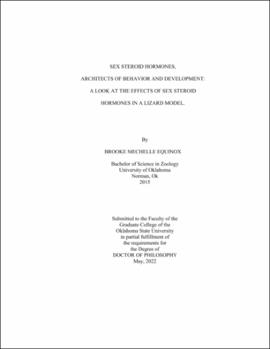| dc.contributor.advisor | Lovern, Matthew B. | |
| dc.contributor.author | Equinox, Brooke Mechelle | |
| dc.date.accessioned | 2023-03-31T19:15:03Z | |
| dc.date.available | 2023-03-31T19:15:03Z | |
| dc.date.issued | 2022-05 | |
| dc.identifier.uri | https://hdl.handle.net/11244/337191 | |
| dc.description.abstract | The mechanisms of sex determination and differentiation in reptilian groups are diverse and largely not well understood. With this study, we hoped to identify to what extent these mechanisms may be overridden by hormonal exposure, whether it be maternal embryonic, or exogenous in origin. We explored the extent of changes acquired by the offspring of Anolis sagrei treated with steroid hormones. Specifically, we documented how the introduction of estradiol (E2 ) and testosterone (T) into the developing embryos of this species early in development affected not only physiology, but also behavioral patterns. In this study, we observed that E2 and T affected many aspects of development. In our first project, we discovered that certain treatment methods for delivering hormones to females when testing maternal effects may be problematic. We specifically tested implantation as a delivery method for the hormones. After implantation, we discovered that oviposition had ceased for all groups, pointing to either a critical effect of stress or an interaction with application method. In this part of our project, we also observed that though oviposition ceased for all groups, our T treated females had a significantly higher number of yolking follicles than our controls. Similar results have been seen in hens and could apply to other reptiles if investigated in future studies. When we adjusted our study to directly treat eggs, we discovered that treatment of eggs with E2 resulted in a female sex ratio bias. For those few resultant male offspring treated with E2, we found that growth (in terms of snout-vent-length and mass) were significantly affected as hatchlings and at 30-days post-hatch. These males tended to be smaller than controls at these time-points, and as adults, they had significantly smaller dewlap-cartilage lengths. This suggests that E2 plays a critical role in the developmental pathway for females and potentially leads to their smaller stature and dewlap lengths as adults. The major results of our behavioral study also identified E2 as the major player. We found that E2 treated females had on average higher aggression scores than controls indicating E2 is involved in the organization of agonistic displays for female development. While we examined these hormones through the lens of approximating maternal and embryonic origin, future studies may want to approach these in terms of toxicological pollutants as many estrogenic mimics have been observed in habitats that are viable for this species. | |
| dc.format | application/pdf | |
| dc.language | en_US | |
| dc.rights | Copyright is held by the author who has granted the Oklahoma State University Library the non-exclusive right to share this material in its institutional repository. Contact Digital Library Services at lib-dls@okstate.edu or 405-744-9161 for the permission policy on the use, reproduction or distribution of this material. | |
| dc.title | Sex steroid hormones, architects of behavior and development: A look at the effects of sex steroid hormones in a lizard model | |
| dc.contributor.committeeMember | Fox, Stanley | |
| dc.contributor.committeeMember | Grindstaff, Jennifer L. | |
| dc.contributor.committeeMember | Hickman, Karen | |
| osu.filename | Equinox_okstate_0664D_17660.pdf | |
| osu.accesstype | Open Access | |
| dc.type.genre | Dissertation | |
| dc.type.material | Text | |
| dc.subject.keywords | anole | |
| dc.subject.keywords | Anolis sagrei | |
| dc.subject.keywords | behavior | |
| dc.subject.keywords | estradiol | |
| dc.subject.keywords | sex ratio | |
| dc.subject.keywords | testosterone | |
| thesis.degree.discipline | Integrative Biology | |
| thesis.degree.grantor | Oklahoma State University | |
